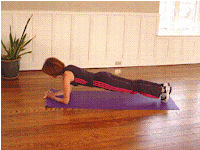What is Core Stability?
Core Stability has become one of the latest trends in the fitness industry. However, this is a trend that is here to stay!
Training the core stability muscles specifically targets the small and deep back and stomach muscles. These muscles control the position of the spine during the dynamic movements of your body. Correct use of your core stability muscles not only decreases your chances of back pain, but also eliminates back pain. In addition, your body's strength, power, endurance and performance will improve as core stability improves. You will be able to run faster, jump higher and even throw further when these muscles work properly.
The pictures displayed below indicate which muscles the ‘core stability muscles’ refer to:
Your spine is the supporting frame for your trunk. Attached to this frame is a complex system of nerves, muscles and ligaments that increases the trunk’s strength and stability.
Most of us are familiar with the six pack muscles known as the rectus abdominis. When we do sit-ups/crunches, they are the muscles that we are strengthening. When we do sideways sit-ups/crunches we strengthen the oblique muscles.
Underlying all of the above, and not visible to the eye, are some deep muscles which are largely responsible for balance, stability and posture. The key component of this muscular system is a deep abdominal muscle called the Transversus Abdominis. Correct activation of this core stability muscle is a lot more subtle than the work of the ‘six pack’ muscles. The instruction commonly used to activate this muscle is ‘to gently draw your belly button inwards towards your spine and create tension across your pelvis’.
Crunches
Lie on the floor (or mat) on your back. Your knees should be bent and feet flat on the floor. Place hands behind head. While exhaling raise your chest until your shoulder blades lift off the floor, slowly inhale and lower back to floor.
Special Instructions: Don't use your hands and arms to help lift you up - use abdominals and hips.
Modified Plank
Begin by lying on your stomach with your forearms on the floor pointing forward, feet together and your spine in a neutral position. Slowly lift your body up on your forearms and toes, keeping your body straight. Maintain this position for as long as possible, remembering to breathe! Challenge yourself to longer periods in the plank position.
Special Instructions: Don’t let your hips/knees drop, your
bottom raise, or weight shift to one forearm.
Superman
Lie facedown on the floor, legs together and straight, arms straight and extended above your head. Keep your head/neck in a neutral position. Simultaneously lift your arms and legs, aim towards the ceiling to form a gentle curve with your body. Hold for a slow 30 counts, remembering to breathe!
Special Instructions: Keep the limbs straight but not locked. Your torso should remain stationary. You can mix it up by alternating leg/arm combinations.
Bicycle Crunches
Begin by lying on your back, place your hands behind your ears. Lift your legs in the air and bend your knees to a 90 degree angle. Move your legs in a bicycle motion, reaching the opposite elbow to knee. Try performing the exercise for 60 seconds in 2 sets.
Special Instructions: To advance the exercise, keep the extended leg straight, and extend to just above the floor.
References
www.physioworks.com.au/core_stability.htm
www.sparkpeople.com.au
For more information
Wesley Corporate Health
Level 2, 46 Edward Street
Brisbane QLD 4000
Phone: 07 3234 2600
info@weshealth.com.au








No comments:
Post a Comment